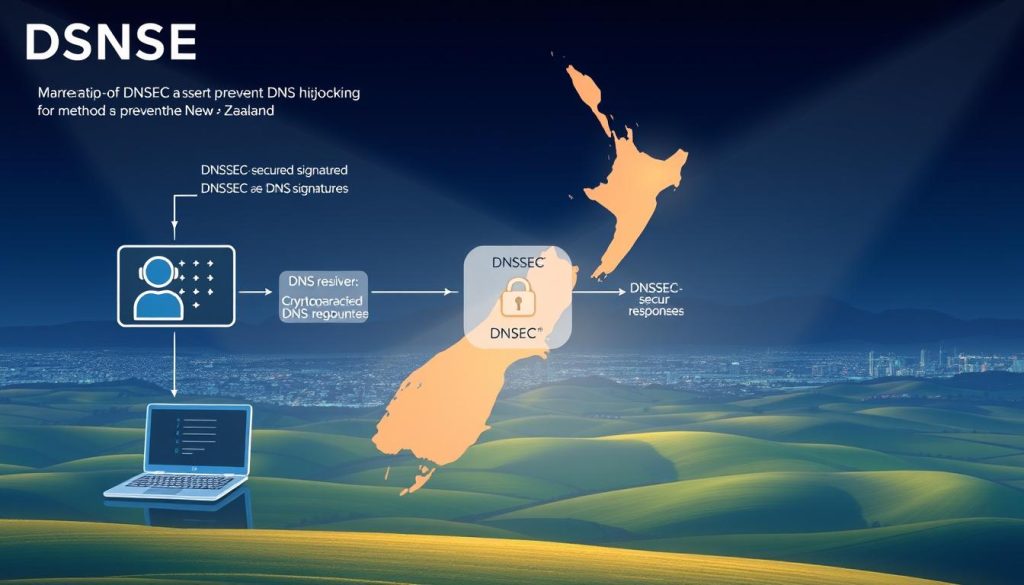DNS Hijacking represents a significant cyber threat where attackers manipulate the Domain Name System (DNS) settings, redirecting users to fraudulent websites. This malicious activity endangers both personal and organisational data security, highlighting an urgent need for effective protective measures. In the land of New Zealand, escalating cyber threats necessitate a proactive approach to understanding and preventing DNS Hijacking. By adopting comprehensive strategies centred on digital safety and DNS mechanisms, users can significantly reduce their risks and enhance their cybersecurity posture.
Understanding DNS: The Backbone of Internet Functionality
The Domain Name System plays a pivotal role within the structure of the internet infrastructure, acting as the bridge between user-friendly domain names and the numeric IP addresses that computers use. This translation is essential for DNS functionality, allowing users to access websites without needing to remember complex numerical strings. The hierarchical organisation of the DNS facilitates rapid communication, which enhances browsing speed through effective caching mechanisms.
Understanding the DNS importance becomes evident when considering the smooth user experiences that today’s internet users expect. DNS streamlines access to websites and services, significantly lowering the chance of human error. Its reliability is crucial, as it underpins countless online activities, from casual browsing to vital business transactions. In summary, the efficient operation of the Domain Name System is foundational to ensuring the ongoing functionality and usability of the internet.
The Importance of DNS Security in Today’s Digital Age
In an era where our lives and businesses heavily rely on the internet, the significance of DNS security cannot be overstated. With increasing digital threats like phishing, malware, and other forms of cyber attacks, it becomes imperative for users and organisations to focus on safeguarding their online presence. DNS, or Domain Name System, plays a crucial role in facilitating internet connectivity and communication.
The vulnerabilities associated with DNS must be addressed to mitigate potential risks. Attackers often exploit weak DNS configurations to redirect traffic or access sensitive information. Advanced cybersecurity measures, such as implementing DNS Security Extensions (DNSSEC), can protect against those risks, ensuring the authenticity of the responses received from DNS servers.
Robust DNS security strategies are essential for maintaining the integrity of websites and protecting precious user data. Without these protective measures, anyone can fall victim to malicious actors seeking to exploit personal or corporate information. Understanding and implementing effective DNS security practices is a foundational step towards a more secure digital environment.
What is DNS Hijacking?
DNS hijacking is a form of cyber attack where attackers redirect DNS queries to malicious websites instead of legitimate ones. This manipulation can lead to significant security risks for users, as their data may be compromised without their knowledge. Understanding the mechanisms behind this process is crucial for maintaining digital security.
The Mechanism Behind DNS Hijacking
The core principle of DNS hijacking lies in the tampering with the DNS resolution process. When users attempt to reach a web address, their device queries a DNS server to retrieve the corresponding IP address. Attackers exploit this system by altering DNS responses, leading users to unsafe domains. Employing DNS spoofing techniques, they can send fake responses, tricking users into visiting malicious sites that could distribute malware or capture sensitive information.
Common Techniques Used by Attackers
Cybercriminals deploy various DNS hijacking techniques to achieve their objectives. One prevalent method involves phishing, where users are lured into clicking on deceptive links or entering credentials into counterfeit websites. Another technique is web redirection, which reroutes users to pages controlled by attackers. Some selected methods include:
- DNS Spoofing: Sending altered responses to DNS queries.
- Man-in-the-Middle Attacks: Intercepting communication between the user and the DNS server.
- Malware Distribution: Utilizing malicious software to gain control over users’ devices.
How DNS Hijacking Affects Internet Users
The effects of DNS hijacking can be extensive, posing significant threats to personal and business realms alike. Understanding these impacts enables individuals and organizations to better navigate the associated risks and implement protective measures.
Impact on Personal Data Security
Individuals become prime targets due to the impact of DNS hijacking. Attackers often exploit vulnerabilities to redirect users to malicious sites, leading to credential theft and identity theft. Such security breaches disrupt users’ lives, resulting in financial loss and reputational harm. Effective awareness and precautionary actions are essential to mitigate these data security risks and safeguard personal information.
Risks for Businesses and Organisations
For businesses, the impact of DNS hijacking carries dire consequences. The potential for operational disruptions can hinder productivity and erode profit margins. Increased phishing attacks frequently target sensitive data, intensifying business cybersecurity threats. Financial losses and damage to client trust may result from these breaches, emphasising the need for robust security protocols and employee training in cybersecurity practices.
Recognising Symptoms of DNS Hijacking
Identification of symptoms of DNS hijacking is crucial for maintaining web security. Users should remain vigilant for recognised indicators that may signal an ongoing attack, as early detection can mitigate potential damage.
Unusual Activities in Browser History
One of the foremost symptoms of DNS hijacking involves unusual activities within browser history. If unexpected entries appear that do not correspond with typical online behaviour, it may indicate a security breach. Users should routinely review their browser history, particularly for sites that seem unfamiliar or irrelevant to their browsing patterns.
Unexpected Redirections and Page Loading Issues
Delays in page loading or unexpected redirections serve as major recognised indicators. For instance, being redirected to unfamiliar websites when attempting to access trusted sites commonly suggests browser anomalies caused by DNS manipulation. Such occurrences require immediate attention to safeguard personal data and secure online activities.
Methods to Prevent DNS Hijacking in New Zealand
To combat DNS hijacking effectively, individuals and organisations in New Zealand should adopt a range of preventive measures. These strategies focus on enhancing security, utilising reliable resources, and maintaining updated equipment to safeguard against potential threats.
Implementing DNSSEC for Enhanced Security
DNSSEC implementation plays a crucial role in ensuring the integrity and authenticity of DNS data. By employing digital signatures, DNSSEC verifies that the data received has not been tampered with, offering a robust defence against various attacks. This additional layer of security greatly reduces the risks associated with DNS hijacking.
Utilising Trusted DNS Services
Choosing trusted DNS services is essential for maintaining a secure internet experience. These services not only provide reliable resolution of domain names but also incorporate advanced security protocols and monitoring to detect and mitigate threats. Opting for well-established providers enhances overall protection against DNS hijacking incidents.
Regularly Updating Network Devices
Regularly updating network devices is another vital step in preventing vulnerabilities that can lead to DNS hijacking. Manufacturers often release firmware updates to address security flaws and improve overall performance. Keeping routers and other network equipment current ensures that potential exploits are mitigated, securing the network from external attacks.

Best Practices for Individual Internet Users
Individuals play a crucial role in ensuring internet safety by adopting specific practices that reduce the risks associated with online threats such as DNS hijacking. By understanding and implementing effective strategies, users can significantly enhance their security posture.
Maintaining Strong, Unique Passwords
Creating secure passwords is fundamental for protecting personal information across various platforms. Strong, unique passwords should incorporate a combination of letters, numbers, and symbols. Users should avoid reusing passwords for multiple accounts. Using a password manager can help in generating and storing these secure passwords safely.
Being Vigilant Against Phishing Attempts
Phishing prevention tactics are essential for defending against fraudulent communications aimed at stealing sensitive information. Users should be cautious about unsolicited emails or messages requesting personal details. Avoid clicking on suspicious links and verify the source before engaging with any requests. Education on recognising phishing schemes contributes greatly to overall internet safety.
The Role of ISPs in Preventing DNS Hijacking
Internet Service Providers (ISPs) hold a pivotal position in the fight against DNS hijacking. Their responsibilities encompass the implementation of robust security protocols to safeguard user data. By configuring secure DNS settings within their networks, ISPs can minimise vulnerabilities that attackers exploit.
One significant aspect of ISP responsibilities includes educating customers about potential threats associated with DNS security. Awareness campaigns may highlight common indicators of DNS hijacking, enabling users to detect and report unusual activities promptly. Furthermore, ISPs are tasked with maintaining an up-to-date infrastructure that can adapt to emerging threats.
ISPs also play a critical role in fostering a secure online environment by collaborating with industry stakeholders. Through partnerships with cybersecurity firms, they can develop advanced detection systems that track malicious activities targeting DNS. Consequently, the combined effort of internet service providers helps establish a more resilient framework against DNS hijacking, benefitting all internet users.
Legislation and Regulations in New Zealand
New Zealand has taken significant steps to establish comprehensive cybersecurity laws aimed at protecting its digital environment. These regulations New Zealand implements require organisations to adopt robust measures designed to safeguard user data against threats such as DNS hijacking. By enforcing stringent standards, the government aims to enhance the security of online transactions and services.
Key aspects of these internet privacy legislation include obligations for data encryption, user consent for data collection, and requirements for regular security assessments. Such frameworks not only uphold consumer trust but also promote a culture of accountability among businesses handling sensitive information.

Through the implementation of these laws, New Zealand positions itself as a leader in digital safety, providing both individuals and organisations with clearer guidelines to reduce the risks associated with cyber threats.
Educational Resources for Understanding DNS Security
In the realm of cybersecurity, DNS security education plays a pivotal role in enabling individuals and organisations to bolster their understanding of online threats. Access to robust training resources significantly enhances skills and knowledge pertaining to DNS protocols and security measures, equipping learners with the tools needed to protect their digital assets.
Online courses focusing on DNS and DNSSEC offer comprehensive insights. These platforms provide structured learning environments where participants can engage with interactive modules, ensuring better retention of critical information. Such educational initiatives promote cybersecurity awareness, fostering a culture of vigilance against potential vulnerabilities.
Workshops and seminars hosted by cybersecurity experts serve as invaluable supplements to formal education. They address current trends and emerging threats alongside best practices in safeguarding DNS systems. By utilising these resources, organisations can create informed teams adept at recognising and mitigating risks.
Emerging Trends in Cybersecurity and DNS Protection
The landscape of cybersecurity is rapidly changing as organisations grapple with evolving threats. Cybersecurity trends indicate a rising focus on DNS protection, particularly given the sophistication of contemporary attacks. Cybercriminals increasingly utilise advanced tools and techniques, merging technological innovations with social engineering strategies to enhance their effectiveness.
One notable trend is the growing implementation of AI and machine learning in detecting and mitigating threats. These technologies provide more robust DNS protection, allowing systems to adapt to the dynamic nature of online threats. By analysing patterns and identifying anomalies, AI can alert administrators to potential issues before they escalate, demonstrating the importance of proactive measures.
Another relevant trend involves the integration of zero-trust architectures. This model assumes that threats could come from both outside and inside an organisation. As such, organisations must continuously validate users and devices trying to access resources. Such vigilance enhances overall cybersecurity, further securing DNS protection protocols from potential breaches.
Partnerships between companies and cybersecurity firms are also gaining traction. Collaborative efforts lead to shared intelligence and resources, equipping organisations to better understand and prepare for evolving threats. This collective approach not only strengthens individual security postures but raises the bar for the entire industry.
Staying informed on these trends is crucial for professionals eager to preempt challenges associated with DNS hijacking and other cyber threats. Continual education and adaptation to new innovations in the field will prove beneficial as the cybersecurity landscape continues to evolve.
Conclusion
In summary, the issue of DNS hijacking poses significant threats to online security, necessitating robust measures for effective prevention. As outlined throughout this article, understanding the fundamentals of DNS and the techniques employed by attackers allows users and organisations to remain vigilant in their defence strategies. This DNS hijacking prevention summary emphasises that awareness and education are key components in safeguarding digital assets.
Securing online presence is not solely a matter for network administrators or IT professionals; it requires collective effort from individual users to corporate entities alike. Best practices, such as implementing DNSSEC and utilising reputable DNS services, contribute effectively to thwarting potential attacks. Being proactive in these areas can significantly mitigate risks associated with DNS hijacking.
As final thoughts on cybersecurity, it is critical to stay informed about the latest developments in threats and protective measures. The digital landscape continually evolves, and maintaining a strong security posture is paramount. By integrating these strategies and harnessing a culture of awareness, users can ensure a safer online experience in New Zealand and beyond.
